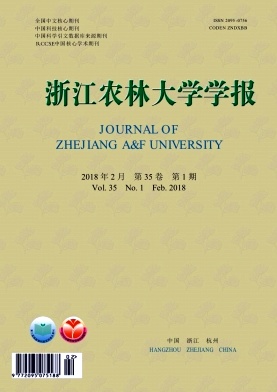-
落叶松八齿小蠹Ips subelongatus给东北以落叶松Larix spp.为建群树种的森林生态系统带来了巨大的经济和生态损失[1-2],被列为中国林业危险性有害生物。在森林生态系统中,小蠹虫与真菌能够形成稳定的伴生关系,这种关系某种程度上属于互惠共生。长喙壳类真菌(ophiostomatoid fungi)为小蠹虫伴生真菌的主要类群[3-5]。许多情况下小蠹虫危害寄主甚至导致寄主死亡的过程中,长喙壳类真菌起到关键作用[6-7]。一些长喙壳类真菌是重要的林木病原物,具有强致病力。如Endoconidiophora polonica在人工接种条件下可以将40年生云杉Picea abies致死[8],而且伴生菌的侵染还可以增加小蠹的危害性[9]。近年来,中国也对落叶松八齿小蠹伴生真菌有一些研究和报道[10-12],主要集中在对伴生菌的鉴定和系统发育分析上[13-14],发现了多种落叶松八齿小蠹伴生长喙壳真菌种类。野外落叶松成熟林接种实验表明:Ophiostoma olgensis和Endoconidiophora fujiensis等2个优势种表现出显著的致病性,这2种真菌可以在内韧皮部和形成层形成明显坏死斑[10, 15]。由于该类病害发生隐蔽,一般很难早期发现和诊治。为了达到早发现早治疗的目的,摸清病害的分布并评估其危害,需要实现对病原菌的快速和准确检测,从而为病害和虫害的防治提供科学基础。快速检测技术已经广泛应用于植物病原物和害虫的检测,如线虫、病原真菌、枣实蝇Carpomya vesuviana和细菌等[16-21]。针对不同物种检测所用方法也不同,特异引物聚合酶链式反应(PCR)检测方法是设计特异性引物来实现对待检目标的特异性检测,国外已有一些长喙壳真菌种类利用该方法实现检测的报道[19-21],但对中国北方落叶松林内分布的病原菌的快速检测一直是空白。传统组织分离法是进行病害鉴定的首要方法,然而受人为和环境因素,以及病原菌的生长特点等影响,往往不能对病原菌实现有效分离。尝试直接从感病寄主组织中提取DNA进行病原菌的特异性检测,是本项研究希望解决的问题。
HTML
-
试验菌株为分离自中国北方的兴安落叶松Larix gmelini,长白落叶松L. olgensis,华北落叶松L. principis-rupprechtii和日本落叶松L. kaempferi林中的落叶松八齿小蠹伴生真菌,包括Endoconidiophora fujiensis等,分布于欧洲落叶松L. decidua林内的近缘种欧洲落叶松八齿小蠹Ips cembrae和欧洲云杉Picea abies林内的近缘种云杉八齿小蠹Ips typographus伴生的长喙壳真菌种类,包括Endoconidiophora laricicola等,以及其他长喙壳真菌近缘种,如分离自山东、浙江的松材线虫病Bursaphelenchus xylophilus伴生长喙壳真菌,菌株详细信息见表 1。除分离自中国的长喙壳类真菌外,其余菌株购自荷兰乌得勒支菌种保藏中心(CBS),或交流自南非林业和农业生物技术菌种保藏中心(CMW),加拿大国家真菌标本和菌种保藏中心(DAOM)和日本筑波大学植物病理与真菌学、生命与环境科学实验室(YCC)。上述菌株保存在中国林业科学研究院菌物保存中心(CFCC)与森林生态环境与保护研究所森林病理实验室(CXY)。
种名 菌株编号 寄主植物/伴生昆虫 采集地 ITS序列登录号 Endoconidiophora fujiensis CBS100208* 日本落叶松/落叶松八齿小蠹 日本 AY233948 CMW1952 日本落叶松/落叶松八齿小蠹 日本 AY233924 CXY1506* 兴安落叶松/落叶松八齿小蠹 中国内蒙古 JC762578 CXY1515* 华北落叶松/落叶松八齿小蠹 中国内蒙古 JC762574 CHY1520* 长白落叶松/落叶松八齿小蠹 中国黑龙江 JC762582 E. laricicola CBS100207* 欧洲落叶松/欧洲落叶松八齿小蠹 苏格兰 AY233910 CBS109260* 欧洲落叶松/欧洲落叶松八齿小蠹 奥地利 AY233918 CMW4522 欧洲落叶松/欧洲落叶松八齿小蠹 苏格兰 AY233908 E. polonica CBS133.38* 欧洲云杉/云杉八齿小蠹 波兰 AY233898 CBS109263* 欧洲云杉/云杉八齿小蠹 奥地利 AY233904 CMW2284 日本鱼鳞云杉Picea jezoensis/云杉八齿小蠹 日本 AY233894 Ophiostoma abietinum CBS125.89 冷杉Abies yabri/平海小蠹Pseudohylesinus swain 墨西哥 AF484453 CHY1555* 长白落叶松/落叶松八齿小蠹 中国黑龙江 JY593322 O. bicolor CBS492.77* 白云杉Picea glauca/白云杉齿小蠢Ips perturbattts 美国 DQ268604 O. cf. bicolor CHY1524* 华北落叶松/落叶松八齿小蠹 中国内蒙古 JY593321 O. brunneo-ciliatum CHY1416* 兴安落叶松/落叶松八齿小蠹 中国内蒙古 JY593323 CMW5214 落叶松Larix sp. 苏格兰 HM031501 O. deltoideosporum CHY1624* 黑松Pinus thunDergii/松材线虫病 中国山东 JY094069 O. floccosum CMW12622 欧洲赤松Pinus sylvestris 奥地利 FJ430472 CHY1412* 兴安落叶松/落叶松八齿小蠹 中国内蒙古 JY593320 O. ips CMW9005 欧洲赤松/松六齿小蠹Ips acuminatus 瑞典 AY546698 CHY1628* 黑松/松材线虫病 中国山东 JY593324 O. kryptum DAOM 229705* 欧洲落叶松/欧洲落叶松八齿小蠹 奥地利 AY304426 O. minus CMW26254 红脂大小蠢Dendroctonus valens 中国 EU785442 YCC658 日本落叶松/落叶松八齿小蠹 日本 GU134172 O. novo-ulmi CMW1461 英国榆Hlmus pocera 美国 FJ430476 O. olgensis CHY1406? 兴安落叶松/落叶松八齿小蠹 中国内蒙古 JU551301 CHY1411? 长白落叶松/落叶松八齿小蠹 中国黑龙江 JU551304 O. cf. olgensis CHY1642? 马尾松/松材线虫病 中国浙江 JY094074 O. piceae CMW 3099 云杉Picea sp. 加拿大 FJ430484 说明:*表示特异PCR检测所用菌株。 Table 1. Ophiostoma and Endoconidiophore species used for developing species-specific sequences primers
-
PCR仪(Biometra,德国),Mixer/Mill 8000高能量球磨机(SPEX CertiPrep,美国),DYY-4型稳压稳流电泳仪(北京六一仪器厂,中国),Alpha imager EP凝胶成像系统(ProteinSimple,美国),天根植物基因组DNA提取试剂盒(离心柱型),核酸染料。
-
在北方3种落叶松林内进行落叶松八齿小蠹虫体样本与坑道组织样本的采集,每个虫体单独保存于灭菌1.5 mL的离心管内,坑道标本分装于干净牛皮纸信封内,自然通风保存。尽快带回实验室用于真菌的分离和DNA的提取。
-
伴生真菌的分离采用组织分离法,用剪刀将坑道标本切成5 mm × 5 mm大小的组织块,用质量分数为1.5%次氯酸钠溶液进行表面消毒处理50 s,后用无菌水冲洗干净。将冲洗干净的组织块放在无菌滤纸上,待表面水分吸干后接种质量分数为2%的水琼脂培养基上,将培养皿封口后置于25 ℃恒温培养箱黑暗培养。培养4 d后挑取菌落外端的菌丝块进行分离纯化,将纯化后的真菌接种到质量分数为2% MEA培养基(麦芽浸粉10 g,琼脂粉10 g,加蒸馏水配制500 mL)进行培养。基于形态学和DNA片段系统发育分析鉴定为Ophiostoma olgensis和Eudoconidiophora fujiensis[14-15]。
-
从菌丝块和韧皮坑道组织样本中提取DNA。菌丝块DNA提取:首先用无菌接种针挑取收集菌丝组织,将菌丝块放入1.5 mL的离心管中,放在-20 ℃冰箱中冷冻,采用北京天根公司植物基因组DNA提取试剂盒推荐的方法来提取DNA。在分别分离到病原菌O. olgensis和E. fujiensis的感病韧皮部组织样本中提取总DNA,方法如下:将样本切成4 mm × 4 mm大小的组织块,放入1.5 mL的离心管中,放在-20 ℃冰箱中冷冻1晚,然后将其放在高能量球磨机中研磨7 min,余下步骤与菌丝组织DNA提取方法相同。
-
分别以Ophiostoma olgensis和Eudoconidiophora fujiensis的ITS序列为目标序列[22-23],通过Blast在基因库(GenBank)上搜索与之亲缘关系较近的菌种已发表的ITS序列(表 1),用MAFFT在线进行序列比对分析。针对目标菌种的特殊序列区域人工设计引物,之后针对引物是否存在发夹结构和二聚体等使用Primer Premier 5.0进行检查。将设计好的引物序列在GenBank中检查序列同源性。针对O. olgensis设计引物15对,针对E. fujiensis设计引物10对,并分别对目标菌种纯培养物DNA进行扩增反应,用琼脂糖凝胶进行电泳检测,通过观察扩增条带的宽度和大小进行筛选,各获得特异引物1对,用于上述菌丝和寄主组织DNA的扩增。引物由北京宝锐通生物科技有限公司合成。PCR扩增反应体系如下:100 mmol·L-1氯化钾,2×Taq PCR MasterMix [500 μmol·L-1三磷酸碱基脱氧核苷酸(dNTP),0.1 U(1 U=16.67 nkat)Taq聚合酶,3 mmol·L-1氯化镁,20 mmol·L-1三羟甲基氨基甲烷盐酸盐(Tris-HCl,pH 8.3)]12.5 μL,双蒸水9.5 μL,模板1.0 μL,引物(浓度1 μmol·L-1)各1.0 μL。针对O. olgensis和O. kryptum的反应条件为94 ℃ 3 min;94 ℃ 1 min,63 ℃ 45 s,72 ℃ 1 min,循环35次;72 ℃ 4 min。针对E. fujiensis的反应条件为94 ℃ 3 min;94 ℃ 1min,64 ℃ 45 s,72 ℃ 1 min,循环35次;72 ℃ 4 min。PCR扩增产物用琼脂糖凝胶(2.2%)进行电泳检测(130 V, 60 min),拍摄电泳照片,观察扩增条带的宽度和大小。
1.1. 实验材料
1.1.1. 试验菌株
1.1.2. 主要仪器与试剂
1.2. 实验方法
1.2.1. 样本的采集
1.2.2. 真菌分离及鉴定
1.2.3. DNA提取
1.2.4. 引物设计及PCR扩增条件
-
筛选获得针对O. olgensis特异性检测的引物1对:OK1(5′-CTCGAACCTTTTTTTTAAACCGT-3′)和OK2(5′-GCCAGCGCACCCAGAA-GGTTGCGC-3′)。对O. olgensis和从落叶松八齿小蠹上分离到的Ophiostoma属真菌及与之亲缘关系较近的其他长喙壳类真菌一起进行PCR扩增,对扩增后的产物进行琼脂糖凝胶电泳分离,结果表明除了O. olgensis和O. kryptum的菌株在248 bp处有一条清晰明亮的条带外,其他菌株均无任何条带(图 1)。

Figure 1. Agarose gel images of PCR amplicons obtained with the specific primers of Ophiostoma olgensis
筛选获得针对E. fujiensis特异性检测的引物1对:EFU1(5′-CTAGAGAATTTATTTTCATTGCTGA-3′)和EFU2(5′-GCAAAGATATGC-GGGTCCT-3′)。对E. fujiensis和从落叶松八齿小蠹上分离到的Ophiostoma属真菌及与之亲缘关系较近的其他Endoconidiophora属真菌一起进行PCR扩增,对扩增后的产物进行琼脂糖凝胶电泳分离。除了E. fujiensis的菌株在251 bp处有1条清晰明亮的条带外,其他菌株均无任何条带(图 2)。
-
提取感染O. olgensis真菌的韧皮部组织样本DNA,以O. olgensis和O. kryptum纯培养物DNA为对照,用特异性引物OK1/OK2进行PCR扩增,对扩增后的产物进行琼脂糖凝胶电泳,均检测到1条248 bp大小的条带(图 3A)。但韧皮部组织DNA的PCR产物条带与O. olgensis和O. kryptum纯培养物DNA的PCR扩增产物相比,条带不够清晰。为了获取清晰条带,以本次感病组织PCR扩增产物为模板,进行第2次PCR反应,反应条件为94 ℃ 3 min;94 ℃ 1 min,68 ℃ 45 s,72 ℃ 1 min,循环35次;72 ℃ 4 min。经琼脂糖凝胶电泳检测到与纯培养物扩增产物一样清晰的248 bp大小的条带(图 3B)。

Figure 3. Agarose gel images of PCR amplicons obtained with specific primers for Ophiostoma olgensis, O. kryptum and Endoconidiophora fujiensis from infectious phloem tissues
提取感染E. fujiensis真菌的韧皮部组织样本DNA,以E. fujiensis纯培养物DNA模板为对照,用特异性引物EFU1/EFU2进行PCR扩增,对扩增后的产物进行琼脂糖凝胶电泳分离。韧皮部组织样本DNA的PCR产物与E. fujiensis纯培养物DNA的PCR产物在251 bp处都有1条较清晰的条带(图 3C)。
2.1. 引物特异性检测
2.2. 感病韧皮部组织样本病原物特异性检测
-
本研究针对落叶松八齿小蠹在中国的优势伴生病原菌O. olgensis和E. fujiensis,分别筛选出2对检测引物OK1/OK2和EFU1/EFU2,能够实现从伴生菌区系和其他长喙壳类真菌近缘种中特异性检测到这2个种,并且得以从感病寄主组织中对病原菌进行直接检测,为实现这2种病原菌的检疫和早期监测提供了条件。
O. olgensis是中国最近发现的一个新种[15],与O. kryptum的亲缘关系十分接近,这2个近缘种的ITS一级结构差异仅在序列两翼。为了能够与其他更广泛的长喙壳类真菌区分,本研究筛选出的特异性PCR引物(OK1/OK2)是选取ITS序列中间区段设计出来的,因此无法区分这2个种。O. kryptum是欧洲落叶松八齿小蠹伴生的病原菌种类[24],目前未发现在中国分布。因此,该引物可以在中国落叶松林内实现对O. olgensis的特异性检测。但由于欧亚大陆的一体性以及落叶松林的广泛分布,O. kryptum有传入中国的潜在威胁,因此下一步工作仍需针对区分这2个近似种进行特异性引物设计和检测。对包括日本在内4个地区不同寄主的E. fujiensis菌株进行了检测,均可得到特异性扩增,表明此方法对E. fujiensis的检测具有普遍适用性。E. fujiensis是落叶松八齿小蠹伴生菌区系中的先锋种和致病力最强的病原菌[14],对它实现特异性快速检测将为制定防治病虫复合危害的有效策略和措施提供科学依据。
近几年,越来越多的分子生物学快速检测技术被运用到病原物和害虫的检疫检测当中,如特异性PCR方法,免疫层析法,环介导等温扩增(LAMP)技术检测法等[25-29]。特异性PCR检测方法相对于传统形态学检测方法优势明显:采用特定序列扩增聚合酶链式反应(SCAR-PCR)的方法研制松材线虫快速检测试剂盒,对松材线虫的检测准确率达100%,弥补了形态学鉴定的不足[16];利用枣实蝇mtDNA的COI基因片段设计并筛选出的特异性引物的SS-PCR方法,实现了对不同虫态枣实蝇的特异性快速检测[17];简单重复序列-聚合酶链式反应(SS-PCR)技术也能够提升美洲斑潜蝇Liriomgza sativae的鉴定与检测效率和准确性[18]。目前国外对约7种长喙壳类伴生菌开展了基于PCR的特异性检测[21, 30-33]。鉴于长喙壳类真菌的致病性及其与昆虫复合危害寄主的特殊性,有必要进一步开展国内其他重要长喙壳类病原真菌的检测研究。本研究仅对感病寄主组织开展了病原菌的检测,下一步仍需对虫体带菌、人工接种等方式优化检测反应体系和定量评估检测的灵敏度。








 DownLoad:
DownLoad:

